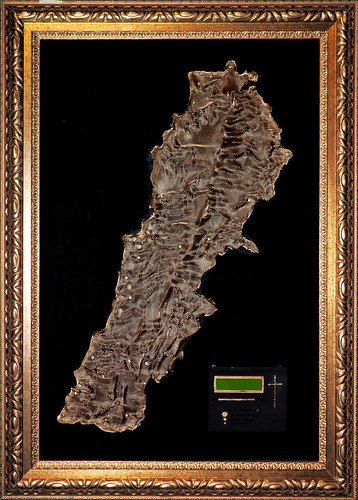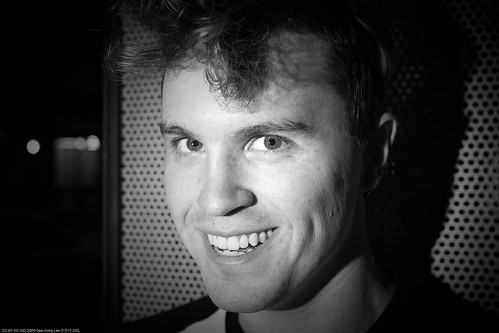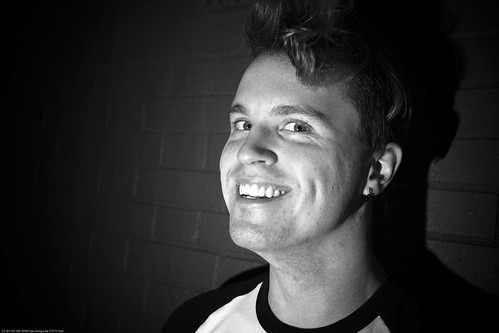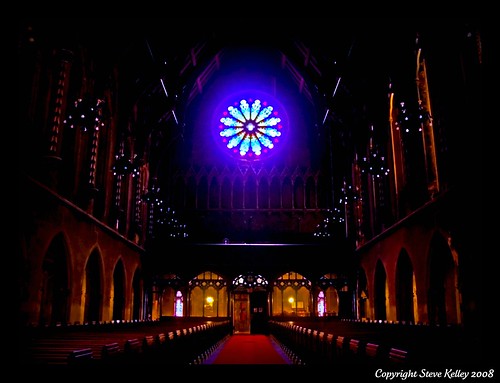Electronics on Canvas: Les Années Lumière by Ayah Bdeir, 2008 / Eyebeam Open Studios Fall 2009 / 20091023.10D.55585.P1.CC / SML
Image by See-ming Lee 李思明 SML
See also Flickr 720p HD video of this mixed media painting in motion + interview with artist's friend (Ayah Bdeir was nowhere to be found during the show...)
Ayah Bdeir
Les Années Lumière
22 x 30 inches
Electronics on Canvas
produced June 2008
in collaboration with Rouba Khalil
A bird’s eye view of a little over 3 years of violence, strife, and very bright lights rocking Lebanon, remembered and replayed in 45 minutes of proportionally timed light display.
www.ayahbdeir.com/category/work/electronics-on-canvas/
Biography
Ayah Bdeir is an artist, engineer and interaction designer. She graduated from the MIT Media Lab with a Masters of Media Arts and Sciences after studying Computer & Communication Engineering and Sociology in the American University of Beirut.
With an upbringing between Lebanon, Canada and the United States, Ayah’s work uses technology to look at cross cultural dialogue and media representation of the Middle East and its identities. Her work spans a range of mediums including interactive installations, electronic fashion, gadgets, reactive furniture, and has been published and exhibited in conferences, festivals and galleries in Amsterdam, Paris, New York, Rhode Island, Boston, London and others, and taught in the graduate Design Technology (DT) Department at Parsons School of Design.
Ayah is now an senior artist fellow at Eyebeam, a gallery for art and technology in Chelsea, New York and teaches at NYU as part of the Interactive Telecommunications Program (ITP) a class entitled ‘Technology as Identity’.
www.ayahbdeir.com/about/
Contact
ayah AT ayahbdeir DOT com
+617 372 3729
540 W. 21st Street, (between 10th and 11th Avenues)
New York, NY 10011
--
littleBits
littleBits is an opensource library of discrete electronic components pre-assembled in tiny circuit boards. Just as Legos allow you to create complex structures with very little engineering knowledge, littleBits are simple, intuitive, space-sensitive blocks that make prototyping with sophisticated electronics a matter of snapping small magnets together. With a growing number of available modules, littleBits aims to move electronics from late stages of the design process to its earliest ones, and from the hands of experts, to those of artists, makers and designers.
littlebits.cc
--
Eyebeam Open Studios: Fall 2009
Eyebeam is pleased to host Open Studios for its 2009 Senior Fellows, Resident Artists, and Student Residents at Eyebeam’s state-of-the-art design, research, and fabrication studio; showcasing video performance, wearable technologies, code and humor, party technology, and sustainablity design.
Eyebeam is the leading not-for-profit art and technology center in the United States.
Founded in 1996 and incorporated in 1997, Eyebeam was conceived as a non-profit art and technology center dedicated to exposing broad and diverse audiences to new technologies and media arts, while simultaneously establishing and demonstrating new media as a significant genre of cultural production.
Since then, Eyebeam has supported more than 130 fellowships and residencies for artists and creative technologists; we've run an active education program for youth, artists' professional development and community outreach; and have mounted an extensive series of public programs, over recent years approximately 4 exhibitions and 40 workshops, performances and events annually.
Today, Eyebeam offers residencies and fellowships for artists and technologists working in a wide range of media. At any given time, there are up to 20 resident artists and fellows onsite at Eyebeam's 15,000-square foot Chelsea offices and Labs, developing new projects and creating work for open dissemination through online, primarily open-source, publication as well as a robust calendar of public programming that includes free exhibitions, lectures and panels, participatory workshops, live performances and educational series.
eyebeam.org/events/open-studios-fall-2009
eyebeam.org
Matthew Borgatti / Eyebeam Open Studios: Fall 2009 / 20091023.10D.55532.P1.L1.C23.BW / SML
Image by See-ming Lee 李思明 SML
Matthew Borgatti (Facebook / Flickr / LinkedIn / Twitter / Vimeo) at the Eyebeam Open Studios Fall 2009, a biennial event in New York City celebrating the synergy between art + technology. Matthew graduated from RISD in 2007 majoring in industrial design. You can check out his portfolio at sinbox.org
Biography
Matthew Borgatti was born with a painfully overactive imagination, grew up a perfectionist and will probably die on a runaway carnival ride. He went to the Rhode Island School of Design and took summers off to build movie monsters in Burbank beginning with Snakes on a Plane and working his way through Aliens VS Predator II: Requiem. After graduating with his degree in Industrial design he moved out to California to make his fortune. Although this didn't exactly work out he spent his time there interning at Instructables, building boats for Makani Power, publishing a book called Show Me How, running industrial robots for a show called Prototype This! and helping everyone from independent inventors developing their first product to artists working on giant sculptures for Burning Man through Instinct Engineering. He once wore a tshirt so witty that people thought he was both sarcastic and sincere at the same time. The paradox stretched the fabric of spacetime so thin that he was able to high five himself. He's currently working at Eyebeam, developing prototypes for and directing the filming of Diana Eng's project Fairytale Fashion.
Eyebeam Open Studios: Fall 2009
eyebeam.org/events/open-studios-fall-2009
Eyebeam is pleased to host Open Studios for its 2009 Senior Fellows, Resident Artists, and Student Residents at Eyebeam’s state-of-the-art design, research, and fabrication studio; showcasing video performance, wearable technologies, code and humor, party technology, and sustainablity design.
///////////////
Eyebeam is the leading not-for-profit art and technology center in the United States.
Founded in 1996 and incorporated in 1997, Eyebeam was conceived as a non-profit art and technology center dedicated to exposing broad and diverse audiences to new technologies and media arts, while simultaneously establishing and demonstrating new media as a significant genre of cultural production.
Since then, Eyebeam has supported more than 130 fellowships and residencies for artists and creative technologists; we've run an active education program for youth, artists' professional development and community outreach; and have mounted an extensive series of public programs, over recent years approximately 4 exhibitions and 40 workshops, performances and events annually.
Today, Eyebeam offers residencies and fellowships for artists and technologists working in a wide range of media. At any given time, there are up to 20 resident artists and fellows onsite at Eyebeam's 15,000-square foot Chelsea offices and Labs, developing new projects and creating work for open dissemination through online, primarily open-source, publication as well as a robust calendar of public programming that includes free exhibitions, lectures and panels, participatory workshops, live performances and educational series.
eyebeam.org
Matthew Borgatti / Eyebeam Open Studios: Fall 2009 / 20091023.10D.55524.P1.L1.BW / SML
Image by See-ming Lee 李思明 SML
Matthew Borgatti (Facebook / Flickr / LinkedIn / Twitter / Vimeo) at the Eyebeam Open Studios Fall 2009, a biennial event in New York City celebrating the synergy between art + technology. Matthew graduated from RISD in 2007 majoring in industrial design. You can check out his portfolio at sinbox.org
Biography
Matthew Borgatti was born with a painfully overactive imagination, grew up a perfectionist and will probably die on a runaway carnival ride. He went to the Rhode Island School of Design and took summers off to build movie monsters in Burbank beginning with Snakes on a Plane and working his way through Aliens VS Predator II: Requiem. After graduating with his degree in Industrial design he moved out to California to make his fortune. Although this didn't exactly work out he spent his time there interning at Instructables, building boats for Makani Power, publishing a book called Show Me How, running industrial robots for a show called Prototype This! and helping everyone from independent inventors developing their first product to artists working on giant sculptures for Burning Man through Instinct Engineering. He once wore a tshirt so witty that people thought he was both sarcastic and sincere at the same time. The paradox stretched the fabric of spacetime so thin that he was able to high five himself. He's currently working at Eyebeam, developing prototypes for and directing the filming of Diana Eng's project Fairytale Fashion.
Eyebeam Open Studios: Fall 2009
eyebeam.org/events/open-studios-fall-2009
Eyebeam is pleased to host Open Studios for its 2009 Senior Fellows, Resident Artists, and Student Residents at Eyebeam’s state-of-the-art design, research, and fabrication studio; showcasing video performance, wearable technologies, code and humor, party technology, and sustainablity design.
///////////////
Eyebeam is the leading not-for-profit art and technology center in the United States.
Founded in 1996 and incorporated in 1997, Eyebeam was conceived as a non-profit art and technology center dedicated to exposing broad and diverse audiences to new technologies and media arts, while simultaneously establishing and demonstrating new media as a significant genre of cultural production.
Since then, Eyebeam has supported more than 130 fellowships and residencies for artists and creative technologists; we've run an active education program for youth, artists' professional development and community outreach; and have mounted an extensive series of public programs, over recent years approximately 4 exhibitions and 40 workshops, performances and events annually.
Today, Eyebeam offers residencies and fellowships for artists and technologists working in a wide range of media. At any given time, there are up to 20 resident artists and fellows onsite at Eyebeam's 15,000-square foot Chelsea offices and Labs, developing new projects and creating work for open dissemination through online, primarily open-source, publication as well as a robust calendar of public programming that includes free exhibitions, lectures and panels, participatory workshops, live performances and educational series.
eyebeam.org
Cathedral of St. Sava
Image by mudpig
Please view on black and large:
bighugelabs.com/flickr/onblack.php?id=2560364660&size...
from the New York Times:
A striking hidden midblock complex on West 25th Street -- an 1855 Episcopal church, an 1866 clergy house and an 1870 school -- is partway into a restoration project likely to be long and expensive. Since the 1940's, it has been the Serbian Orthodox Cathedral of St. Sava, and even for native New Yorkers both the exterior and interior are likely to be a surprise.
The new Trinity Chapel became one of New York's most socially important churches -- Edith Jones had plenty of time to reflect on her imminent marriage as she walked down the long aisle to marry Edward R. Wharton in April 1885. She did not turn back, although she soon became disenchanted with her husband and developed her writing career around the turn of the century.
Fashion continued to move uptown and by the 1910's the side streets west of Madison Square were filling with loft buildings -- leaving the Trinity Chapel complex an oasis. Trinity Church decided to abandon its little outpost and The Times observed that ''no tears will be shed; it has never been considered a landmark,'' adding ''perhaps it is better to tear the building down than to build little additions to it and let the old church remain, battered and unsightly.''
Trinity Chapel remained open, and the Trinity parish thought enough of it to remove stained glass and other artwork in early 1942, during air raid concerns after Pearl Harbor. But later that year the parish put the chapel on the market, selling it in 1943 to members of the Serbian Orthodox Church, who established the old Trinity Chapel as the Cathedral of St. Sava, named after a 13th-century saint who became the first archbishop of Serbia. King Peter II, the exiled king of Yugoslavia, attended services here in the 1940's and never returned to his native land, which was still under Communist rule when he died in 1970.
Later the Communist Party of the United States moved into 23 West 26th Street, and between 1964 and 1972 there were a half-dozen bombings at their building. In 1966 a powerful one blew out the stained-glass windows in the apse of St. Sava, and the cathedral replaced them with ones of a Byzantine design, more familiar to practitioners of the Eastern Orthodox religion. Two years later the exterior of the complex was designated a landmark.
No comments:
Post a Comment